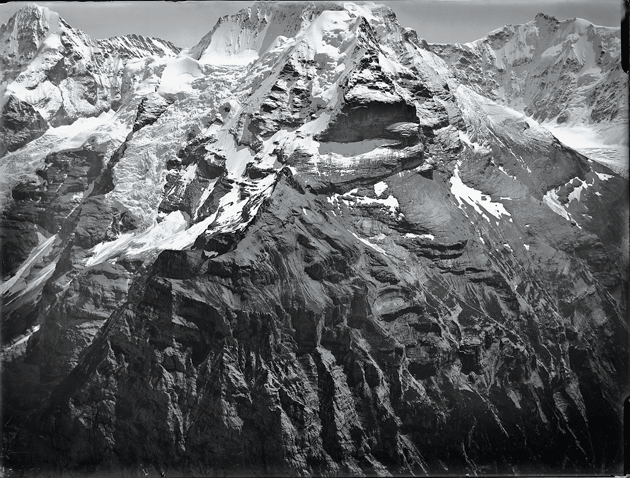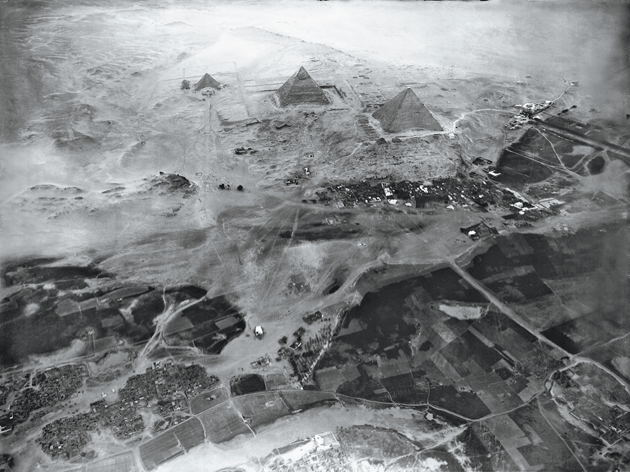Falling Upwards: How We Took to the Air, by Richard Holmes. Pantheon. 416 pages. $35.
Some years ago, when I lived in California, a colleague — a distinguished silver-haired English historian — got a surprise birthday present from his wife: a sunset hot-air-balloon trip. “It sets the perfect stage for your romantic escapade,” the balloon company’s advertising copy reads, recommending balloons as ideal platforms for marriage proposals as well as weddings, anniversaries, and birthdays. “Your loved ones will thank you for the time of their lives!” Champagne and soft drinks are part of the package: $350 a couple for an hour in the air. For my colleague, what began as fantasy ended in farce. Caught in unfavorable winds, the balloon came down where it was not meant to. Dignity wounded, but not much else, the couple, their picnic basket, and the empty champagne bottles were decanted into the middle of a suburban boulevard, to hoots of derision from a small pack of adolescents.
Modern ballooning can be a mass spectacle too. Every year in October, hundreds of hot-air balloons launch into the blue skies above Albuquerque, New Mexico, and almost a million people come to watch. The special-shapes section of the event has had balloons in the form of a saguaro cactus, a Halloween pumpkin, a champagne bottle, a Pepsi can, SpongeBob, and Airabelle the Flying Cow with her Beautiful Udder (advertising a local dairy).
Apart from the occasional high-rise scientific experiment, sky-dive record attempt, and Richard Branson–sponsored transatlantic adventure, that’s pretty much what ballooning has become — the Ascent of Man as brief encounter with the lower atmosphere, as photo op, as advertisement, as intimate romantic gesture. But that’s not how it all started: in its late-eighteenth-century beginnings, ballooning was a Romantic gesture on the grandest of scales, and it takes one of the great historians and biographers of the Romantic era to retrieve what it once signified.
Published in 2009, Richard Holmes’s The Age of Wonder: How the Romantic Generation Discovered the Beauty and Terror of Science is a thrilling survey of how the Romantics saw the relationship between science and the literary imagination. Beauty combined with terror was the definition of the Romantic notion of the sublime, which wedded aesthetic pleasure to fear, the darkness of unreason, and the power of mysterious forces. There was no Two Cultures problem: poets and novelists embraced and were moved by the scientific imagination. In science itself, the sublime flowed from new understandings of electricity, magnetism, gases, and telescopically revealed nebulae; in science fiction, the pattern of the sublime was Mary Shelley’s Frankenstein; in painting it was represented by the brooding landscapes of Caspar David Friedrich and the light-storms of J.M.W. Turner; and in poetry it was Wordsworth’s “Tintern Abbey”:
Of aspect more sublime; that blessed mood,
In which the burden of the mystery,
In which the heavy and the weary weight
Of all this unintelligible world,
Is lightened . . .
And what could shake off the weight of earthiness, inspire awe, and instill terror better than a balloon ascent? The pleasure is in the birdlike leap into the air, the peaceful silence, and the grandeur of the aspect. The terror lurks above and below. An uncontrolled ascent means frostbite, asphyxia, and death in the deep purple of the stratosphere; an uncontrolled return shatters bones and ruptures organs.
We’ve always aspired to up-ness: up is virtuous, good, ennobling. Spirits are lifted; hopes are raised; imagination soars; ideas get off the ground; the sky’s the limit (unless you reach for the stars). To excel is to rise above others. Levity is, after all, opposed to gravity, and you don’t want your hopes dashed, your dreams deflated, or your imagination brought down to earth.
In 1783, the French inventor and scientist Jacques Alexandre Charles wrote of the ballooning experience as if the envelope were filled not with hydrogen but with laughing gas: “Nothing will ever quite equal that moment of total hilarity that filled my whole body at the moment of take-off. . . . It was not mere delight. It was a sort of physical rapture.” You go up and you get light-headed. “The first impression [on ascent] is a novel sensation of well-being or contentment,” the French astronomer and balloonist Camille Flammarion wrote. Guy de Maupassant took a ride in a balloon in 1887 and reported that a “profound and hitherto unknown sense of well-being flooded through me . . . a feeling of utter carelessness, infinite repose.” It’s just right that a remarkable proportion of early balloonists seem to have packed champagne, with the bonus that the empties could be thrown out to reduce weight. Levels of Life, Julian Barnes’s moving meditation on grief, casts the aspirations of early ballooning, like the flight of Icarus, as a tragicomedy of human limits and the yearning to transcend them.
In the beginning, birds flew, and God made the birds. Angels flew, and God made the angels. Men and women had long legs and empty backs, and God had made them like that for a reason. To mess with flight was to mess with God. It was to prove a long struggle, full of instructive legends.
The invention and early years of ballooning occupy one chapter in The Age of Wonder, but Holmes has long been smitten by the subject, and Falling Upwards is a glorious, fizzing book about manned ballooning from the first theatrically staged French ascents in 1783 to the disastrous Swedish attempt to reach the North Pole in 1897 — “the last great romantic balloon expedition of the nineteenth century.”
How did balloons work? They ascended because they were lighter than air, and there were two main ways of achieving levity. The first flight was taken in an aerostat designed by the Montgolfier brothers whose buoyancy was provided by hot air — dangerously generated by a smoky fire in a brazier fixed under the neck of the envelope. (The balloon stayed up just as long as its enclosed air was hot.) Soon balloons were being lifted by lighter-than-air manufactured gases, first hydrogen — produced by passing sulfuric acid over iron scraps — and, later, coal (or town) gas, which from the 1820s on could be tapped from the municipal mains. Since hang time was a matter of retaining gas, it was vital that the envelope leak as little as possible: varnished silk was used in early designs, with the panels (or gores) very carefully stitched together. (Both gas and silk were expensive, so ballooning was a game either for rich men or for those who could get rich men’s backing. The cost of the 22,000 yards of silk for Le Géant, an enormous French balloon constructed in 1862, was £6,000, equivalent to perhaps $10 million today.)
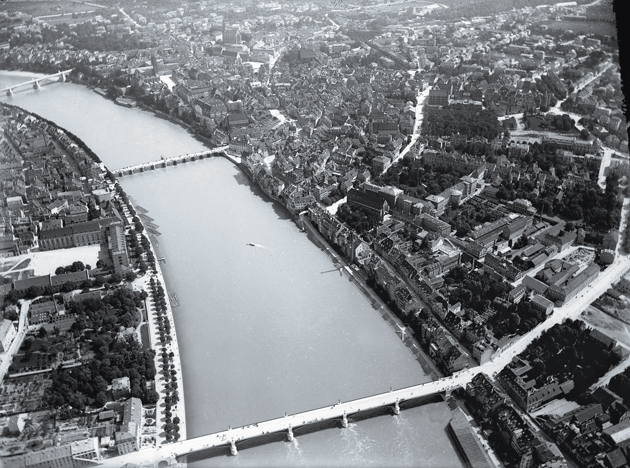
“Basel with the Rhine bridges, viewed from the north,” courtesy Swiss Federal Archives for Historic Monuments, Eduard Spelterini Collection. All photographs by Eduard Spelterini, who in 1898 became the first person to cross the Alps by air. A monograph of his aerial photography on glass negatives, Eduard Spelterini: Photographs of a Pioneer Balloonist, was published in 2007 by Scheidegger & Spiess, and a selection of his work was on view in November at the Venice Biennale.
You could increase levity by stoking the fire (in the case of the genre that became known as montgolfières) or, with the hydrogen-filled balloons called charlières (after Jacques Charles, one of their inventors), by throwing overboard some sand-filled ballast bags. With gas balloons, altitude could be compromised by added weight from icing and the accumulation of moisture, and from temperature changes. The higher the ambient temperature, the greater the lifting power of the gas, but you didn’t want the gas to expand so much that the envelope exploded. Descending was always tricky: with the hot-air design you damped the fire, and with hydrogen or coal-gas balloons there were release valves. Grappling irons or anchors were used on landing to seize on to something on the ground. Later innovations were intended to make landings less lethal: around 1830, a heavy drag rope was introduced, trailing the aerostat to reduce both its forward and its downward speed, and a rip panel in the envelope could be torn away at the last minute to achieve rapid deflation.
Controlling a balloon’s lateral movement is easier to summarize: you couldn’t do it in the Romantic era and, for all practical purposes, you still can’t. There were attempts throughout the nineteenth century to steer balloons by using a complex of ropes and sails, but they didn’t particularly work. What you can hope to do is find an altitude where the winds are blowing in the direction you want to go, and the fact that this is now somewhat easier owes much to the wind-charting observations carried out by nineteenth-century aeronauts.
Balloonists often wound up far from their intended destinations; some found themselves going backward; others disappeared into the vastness of the ocean and were never seen again. With the spectacular use of balloons to carry people and messages out of Paris during the 1870 Prussian siege, some landed where they were meant to, west and south of enemy lines; one came down in Norway; and several, unluckily, descended in Germany, where the aeronauts were shot as spies. No balloon ever managed a return journey to Paris: microfilm-carrying homing pigeons proved much more successful.
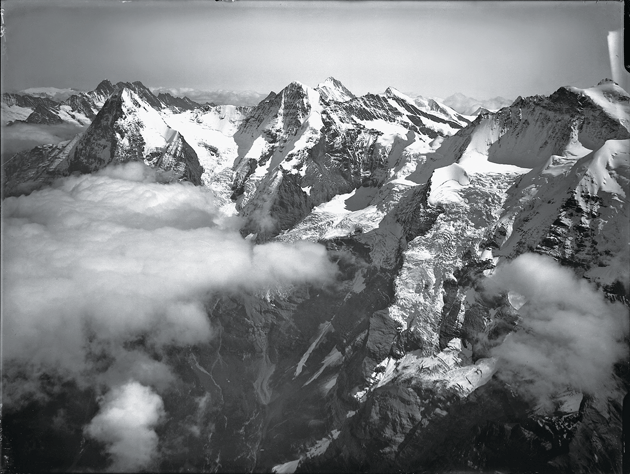
“Eiger, Mönch, Finsteraarhorn, and Jungfrau from an altitude of approx. 4,000 m, viewed from the west,” courtesy Swiss Federal Archives for Historic Monuments, Eduard Spelterini Collection
In 1863, the well-financed and well-catered Le Géant was launched from Paris on what was supposed to be a long-distance eastward flight, perhaps as far as Poland or Russia. Dining over Belgium, the six passengers opened half a dozen cases of fine wine, and for breakfast the next day over Germany there were croissants and coffee. Later, after much tactical deliberation, the aeronauts decided to touch down in an open field to the west of Hannover. Le Géant began careering over fields at thirty miles an hour, crashing into trees and shearing off branches, nearly running into an oncoming train (which braked just in time), before being confronted with the other great communications technology of the nineteenth century, a string of telegraph wires running parallel to the rails (“Four electric wires — four guillotines,” the chief aeronaut recalled thinking). The balloonists miraculously survived that encounter, though they bounced across German farmland for a further ten miles before coming to rest. The optimistic entrepreneur who had organized the flight turned disaster into commercial opportunity by producing a sensational book about the crash landing, illustrated by a lithograph of the balloon-train encounter. The image was copyrighted, and royalties from its reproduction helped finance not only reconstruction of the great balloon but a publicity campaign to drum up support for building a heavier-than-air “aero-locomotive” that really could be steered.
Balloons were understood as cutting-edge science, but, like Frankenstein with his monster, human beings couldn’t completely control these creations — and that play between human ingenuity and the awesome power of nature was a part of what elicited an aesthetic and emotional response to ballooning. In 1871, Flammarion gloried in his submission to the balloon’s dynamic will: “Thou shalt fly off to the regions of storms and tempests, and I shall be forced to follow thee! I shall become thy plaything; thou shalt do what thou wilt with me.” Holmes cites, but doesn’t clearly endorse, another writer’s suggestion that the Victorian balloonist represents a “Freudian ‘regression’ into a passive, childlike, dreamlike, oceanic or ‘infantile’ state,” floating above the earthly world of “masculine effort and control.”
This is mere psychobabble, but there was certainly something louche about the theater of women on an aerial stage. Balloons assumed a minor role as erotic technology when enterprising French aeronauts began taking their attractive wives, girlfriends, and young nieces for gaseous rides. In 1799, André-Jacques Garnerin arranged for his wife, Jeanne-Geneviève, to perform the first parachute jump from a balloon by a woman, and soon she had an equally audacious French rival in Sophie Blanchard. Sophie had developed an infatuation with balloons as a child, after witnessing an ascent by the dashing, then-married-with-kids aeronaut Jean-Pierre Blanchard. The coup de foudre was approximately mutual, for Blanchard felt for the little Sophie what she felt for the big balloon, and, as rumor had it, vowed to marry her when she was eighteen. “Sensation incomparable!” she cried on her first ascent with Blanchard, in 1804. They eventually married when Sophie was twenty-six, and soon she became a crucial part of his touring act.
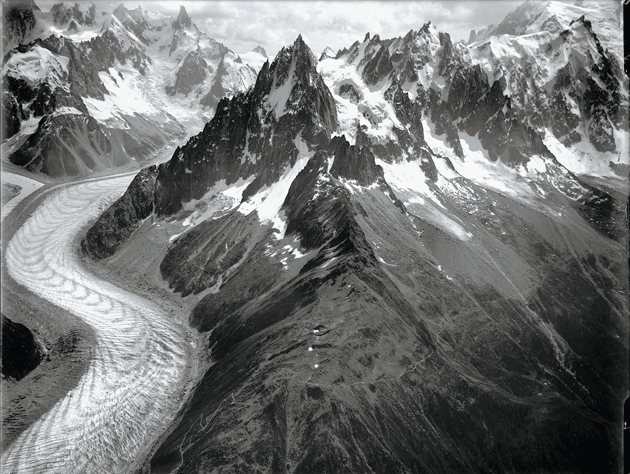
“Mont Blanc group from an altitude of approx. 2,800 m, viewed from the north, 8 August 1909,” courtesy Swiss Federal Archives for Historic Monuments, Eduard Spelterini Collection
Shy on earth, Sophie was transformed into a fearless exhibitionist at 500 feet, and she continued solo after Blanchard died, in 1810. Adopting flamboyant attire, she wore large, extravagantly feathered bonnets, white cotton dresses with high waists, and low décolletage. She disdained the more capacious baskets used by other balloonists, flying instead in a tiny silver gondola whose sides were barely a foot high. It was, Holmes writes, “like standing in a flying champagne bucket.” Her professional specialty was nighttime pyrotechnic displays over the Parisian gardens of Tivoli and Luxembourg, setting off rockets, cascades, and the blue-colored flares known as Bengal lights. She became such a star that Napoleon made her official aeronautical entertainer for state festivals, and after the Bourbon Restoration she was appointed to a similar position under Louis XVIII.
Sophie’s end, when it came in 1819, was suitably theatrical. Ascending from Tivoli one summer’s night, she had just begun her displays when the hydrogen in her envelope caught fire. The crowd below thought it was yet another stunning dramatic effect, and cheered wildly. The flaming balloon fell onto the roof of a building in the Rue de Provence, and while still tangled in the rigging Sophie clung for a while to a parapet high above the street. “À moi, à moi!” she cried out to the shocked spectators, before losing her grip and falling to her death. Sophie’s sensational last show was reported throughout the world.
The dangers of this sort of thing were now thoroughly appreciated, but the heyday of risqué female ballooning was still to come. In the 1850s, another French aeronaut, Eugène Godard, took his wife and a troupe of saucily dressed young women on a tour of America, where, suspended beneath the balloon, they performed acrobatics on trapezes and, incredibly, rode horses on platforms slung below the balloons. By the end of the century, such displays had become fixtures at both British and American fairs. In 1891, a Yorkshire poster announced that “Miss Maude Brooks will Drop from the Clouds” at the Rotherham Cricket Grounds: “She will endeavour to alight within the Grounds, but in the event of not doing so, will return with all possible speed, appear on stage, and give an account of her Aerial Voyage.” Some women balloonists reckoned they were aiding the suffragette movement; others saw themselves as circus performers. The shows went on in Britain until the outbreak of the Great War, when the national mood became less playful.
“Any balloon flight,” Holmes writes, “was always essentially a piece of theatre.” From the start, balloons were enormously engaging spectacles. As early balloonists wafted across the French countryside, amazed and delighted landowners called up, inviting the aeronauts to land and share a light collation of cold chicken and (of course) champagne. Jacques Charles’s first ascent was said to have drawn 400,000 spectators, among them Benjamin Franklin, who, when asked what was the use of a balloon, replied: “What’s the use of a new-born baby?” Franklin himself soon thought up some practical things to do with balloons, and so did many others. The military could use them: Franklin first suggested that a fleet of balloons could transport an invasion army, for example, from France to England. During the Revolutionary and Napoleonic Wars, British observers tended to regard all balloon sightings as potentially hostile, but the caprice of the winds scotched the idea of airborne military vehicles and, indeed, any notion of using balloons as practical forms of military or civil transport. (Balloons might move over the ground at astonishing speeds — twenty, thirty, even ninety miles an hour — but, from the 1820s, trains had the advantage of showing up where they were supposed to.)
A better military concept was using balloons to gather intelligence. Send them up tethered to the ground and the aeronauts could overlook the enemy and note their disposition of forces. The French Revolutionary Army established a balloon regiment in 1794 for surveillance purposes, with mobile gas-generating facilities designed by the chemist Antoine Lavoisier, and in 1797 Napoleon took the Corps d’Aérostiers along with him in his invasion of Egypt. (Before the balloons could be unloaded, Admiral Nelson destroyed them all in the 1798 Battle of the Nile.) The high point of nineteenth-century military ballooning was in the American Civil War, when Northern entrepreneurs aggressively sold President Lincoln on the idea of forming a balloon corps in the Union Army. Balloons were used to some effect in the bloody Virginia Peninsula campaign of 1862. At 1,000 feet, a tethered balloon could survey Confederate forces up to twelve miles away, dropping down notes to be taken to the Union general or using a telegraph wire strung along the tethering rope. In the Siege of Yorktown, a Union general went up himself to confirm a secret rebel withdrawal from the town.
The Confederates didn’t have much of a technological response, but the remarkable episode of the “Silk Dress Balloon” in the defense of Richmond became part of Southern legend. The balloon envelope was said to have been sewn up from “a shimmering mass of multicolored silks” cut from ballroom dresses patriotically donated by dozens of Southern women. It was, Holmes writes, “a balloon made of gleaming Southern dreams” — Up in the Air as Gone with the Wind. The Rebel balloon was meant to be launched over Richmond from a small tugboat, but a Union gunboat captured both tug and balloon. Writing many years after the war, a Confederate general described the seizure as an act of “ungallantry”: it was “the meanest trick of the War, and one I have never yet forgiven.”
The value of the information provided by balloons ran up against the endemic intelligence problem of interpreting what was seen, and the fog and dust of war made seeing no easy matter. The Union corps was disbanded after 1862 and balloons played no further part in the war — but the perspective they offered powerfully affected nineteenth-century aesthetic, social, and political sensibilities. In 1871, the English scientific aeronaut James Glaisher celebrated what the balloon had achieved: “it has done for us that which no other power ever accomplished; it has gratified the desire natural to us all to view the earth in a new aspect.” True, tall peaks had been climbed, but as Flammarion wrote:
The grandest and most sublime view seen from the summit of a high mountain . . . bears no comparison to the beauty of nature as seen perpendicularly from the regions of space. Thus only can we perceive the beauty and grandeur of nature in all its sublimity.
The “Earthrise” photograph taken by Apollo 8 in 1968 became an icon of the environmental movement, but it was with balloons that, as Holmes writes, “Man’s growing impact on the surface of the planet for the first time became visible.”
Seeing earth from a new point of view made a strong impression. More surprisingly, so did hearing it. Some of the most lyrical passages in the genre of balloon writing are accounts of the receding terrestrial soundscape. Drifting above the Surrey countryside in 1863, even the scientifically restrained Glaisher was moved to aerial idyll:
The cheering cry of children was frequently heard above all other sounds. Geese cackled, and, frightened, scuttled off to their farms; pheasants crowed as they were going to roost, and as we approached the end of our journey packs of dogs barked in the wildest state of excitement.
Gliding at night over Belgium in 1836, the British balloonist Charles Green and his crew reported on the Industrial Revolution made eerily audible. They were, Holmes says,
gradually overwhelmed by the thunderous machine noise, the choking industrial smells, and the haunting sound of men below still working on the night shifts. There was disembodied shouting, coughing, swearing, metallic banging and sometimes, weirdly, sharp echoing bursts of laughter.
The soundscape of a metropolis offered a particular political resonance. For Glaisher, London from a mile high sounded “like the roar of the sea.” And from 7,000 feet, “the roar of the town . . . was a deep, rich, continuous sound — the voice of labour.”
Aeronauts repeatedly said that the earth below looked like a map, and here it was a fortunate historical accident that the cartographic convention of portraying territory from above — from a view that, it was thought until the 1780s, no one could ever have — was available to frame views from a balloon that no one had ever had before. Early balloonists, that is, for all their amazement, knew what to see when they looked earthward. The smallness of big terrestrial things was soon taken as a matter of course — people were “ants” and buildings were “toys” — but other features of the view de haut en bas were less expected and richer in implication. Here it all was — cathedrals, castles, and working-class houses, town and country — “standing side by side in friendly juxtaposition,” as one English balloonist put it, “mixed up together in the one scene” as if conjured “by the magic virtues of some great enchanter’s wand.” The high and the low, from the balloon’s perspective, were seen on a level. “All perception of comparative altitudes of objects on or near the ground is lost,” Glaisher noted, “and the whole has the appearance of a plane.”
The politics of the balloon’s leveling perspective gripped Romantic and radical imaginations. A cat may look at a king, and from the balloon you could look down on whomever and whatever you wanted. A balloon ignored national borders; it needed no passport; it inspired thoughts of freedom in the earthbound, the oppressed and enslaved. Percy Shelley fancied that a balloon appearing in the skies over Africa “would virtually emancipate every slave, and would annihilate slavery forever,” and Victor Hugo promised that ballooning would bring about “the liberation of all mankind,” “universal peace and freedom.”
Holmes doesn’t find this entirely ludicrous: air travel and satellites, he writes, “are the sine qua non of our global civilization; and space flight may yet become the final means of its salvation.” But that’s going a bit too far. By the end of the nineteenth century, the future lay, Holmes acknowledges, not with the gaseous cloud but with the heavy mechanical bird. Holmes breaks off his story with the emergence of new technologies for taking to the air — engine-powered dirigibles and fixed-wing aircraft, both of which were rapidly recruited into military arsenals and profit-making enterprises. The zeppelin was never intended as a platform for Romantic imaginations and airplane travel far above the clouds has long ago lost whatever romance it once had. But the propane-fired hot-air balloon is still with us: you can go up in one on a summer evening, floating in a most peculiar way, marveling at the peace and serenity, looking down on the throb of modern civilization. And then you come back to earth.

